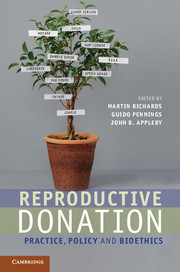Book contents
- Frontmatter
- Contents
- Contributors
- Acknowledgements
- 1 Introduction
- 2 The biology of donation
- 3 Ethics for reproductive donation
- 4 Parenthood – whose right is it anyway?
- 5 Reproductive donation
- 6 UK and US perspectives on the regulation of gamete donation
- 7 Gamete and embryo donation
- 8 The legal and ethical regulation of transnational donation
- 9 Balancing ethical criteria for the recruitment of gamete donors
- 10 Challenges in intra-family donation
- 11 ARTs and the single parent
- 12 Reproductive donation and justice for gay and lesbian couples
- 13 Is disclosure in the best interests of children conceived by donation?
- 14 Identifiable donors and siblings
- 15 Ethical issues in embryo donation
- 16 Reproduction through surrogacy
- 17 Some conclusions regarding the interaction of normative and descriptive elements in reproductive donation
- Index
- References
1 - Introduction
Published online by Cambridge University Press: 05 August 2012
- Frontmatter
- Contents
- Contributors
- Acknowledgements
- 1 Introduction
- 2 The biology of donation
- 3 Ethics for reproductive donation
- 4 Parenthood – whose right is it anyway?
- 5 Reproductive donation
- 6 UK and US perspectives on the regulation of gamete donation
- 7 Gamete and embryo donation
- 8 The legal and ethical regulation of transnational donation
- 9 Balancing ethical criteria for the recruitment of gamete donors
- 10 Challenges in intra-family donation
- 11 ARTs and the single parent
- 12 Reproductive donation and justice for gay and lesbian couples
- 13 Is disclosure in the best interests of children conceived by donation?
- 14 Identifiable donors and siblings
- 15 Ethical issues in embryo donation
- 16 Reproduction through surrogacy
- 17 Some conclusions regarding the interaction of normative and descriptive elements in reproductive donation
- Index
- References
Summary
This volume offers a survey of the practices of reproductive donation and a discussion of the social and ethical issues that these may raise. Our focus is on collaborative, or third-party reproduction. Here a child is not conceived through sexual intercourse by the parents, but rather the conception is likely to take place in a clinic with others involved in providing the eggs, sperm, embryo or sometimes the uterus in which the fetus grows. Typically in collaborative reproduction, roles are separated, so that these third-party progenitors do not become parents and usually play no part in the lives of the children they help to create. Indeed, it is often the case in collaborative reproduction that the children are unaware of the part that others have played. Within the technologies and practices of assisted reproduction, a child can have up to five progenitors: a social mother, a social father, a biological father (sperm provider), a biological mother (egg provider) and a surrogate (gestational) mother.
There are a number of different reasons why people may turn to collaborative reproduction. It can provide a means of overcoming infertility. So where, for example, a man’s sperm is defective or not produced in sufficient quantity, or a woman no longer has viable eggs because of her age, gametes (egg or sperm) from a third party can provide a substitute. Without such collaborative reproduction, their only other possibility of having a child would be to adopt. The main difference, obviously, is that an adopted child is not a blood relative of either parent.
- Type
- Chapter
- Information
- Reproductive DonationPractice, Policy and Bioethics, pp. 1 - 12Publisher: Cambridge University PressPrint publication year: 2012
References
- 4
- Cited by



